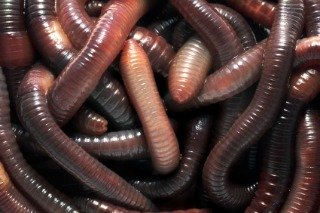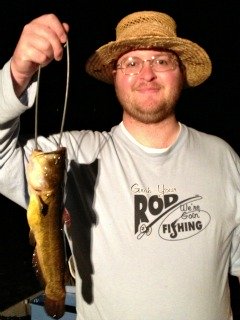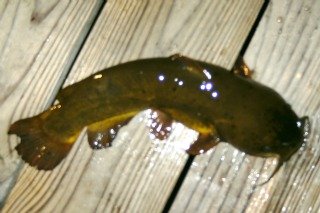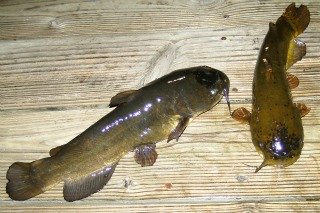Bullhead Catfish Fishing Tips: Part 1
Ready For Some Real Fun?
Fishing for bullhead catfish is easy, fun, and productive if you’re good at it. But if you’re not any good, it’s probably a real pain!
I’m going to tell you all about bullhead catfish and how to fish for them. You’ll be able to catch dozens of bullheads quickly.
You‘ll also know how to handle, clean, and cook them.
Why go bullhead fishing? To start with, these fish are relatively easy to catch. You get a lot of fast action. You can often fish for bullheads from shore.
These factors make bullheads a good fish to target if you're new to fishing. You can practice using your tackle while you get easy bites from bullheads.
You won’t need expensive tackle; simple gear is fine. The baits are cheap too.
Bullheads are great fun on light tackle. They are fairly strong for their size. Bullhead catfish fight hard, sometimes breaking light line.
When taken from clean and rather cool water, bullheads are very tasty. There is often no creel limit set by wildlife agencies. The creel limits that do exist are usually very generous.
For instance, Utah’s limit is 24 bullheads per day to each angler. In many states, there are no closed seasons for bullheads.
Bullheads are an amazing bait for monster catfish. I recommend 4-6” bullheads for catfish from 5-20 lbs. For catfish bigger than 20 lbs, you’ll need 6-12” bullheads.
Big catfish defend their territory. They hate having a pesky little bullhead in their space. That bullhead must die and the quickest solution is for the monster catfish to eat it in one gulp!
Unique Facts About Bullhead Catfish
Bullheads are also called “pollywogs“; “pollies“; “mud cats“; “horned pout“; “hornpout“; “river cats”; "barbotte"; and other names. I use several of these terms interchangeably in this article. Whatever you call them, bullhead catfish have some unusual abilities.
Bullheads can survive almost anything. They tolerate pollution much better than other fish. Low oxygen is not a problem either. A bullhead catfish can even stay alive for several hours out of water!
Bullheads also do okay in brackish water. They can tolerate water temperatures over 90 degrees. Once bullheads arrive in a body of water, they’re almost certain to be there for good.
Like most North American catfish, the hornpout has eight barbells (whiskers). The barbells have taste buds all over them.
Bullhead catfish have no scales. They're just covered in skin.
Bullheads have strong jaws, and dozens of needle-like teeth inside their mouths.
My brother learned this the hard way. He stuck his finger in a bullhead's mouth. He'll never do that again!
The head is the largest part of a bullhead’s body. They have very wide, large mouths for a fish of their size.
Bullhead catfish travel in schools looking for food. They eat practically everything in the natural world, though they have their favorites. The list of common bullhead food includes:
- insect larvae
- vegetation
- adult insects
- fish eggs
- leeches
- crayfish
- aquatic worms
- algae
- minnows and small fish
- snails
They'll even eat sewage, but only where it's available.
Like all catfish, bullheads can "sting" you. It is not the barbels (whiskers) that sting. Rather, there are three fins to watch out for.
The dorsal fin is on the top of the fish behind the head. The two pectoral fins extend sideways behind the head. Bullhead catfish can inject poison with the spine on any of these three fins.
I myself have never been “stung,” but I hear it’s pretty painful. In fact, it’s probably worse than a bee sting. My dad did get stung once and he was hurting for a week.
If a bullhead jabs you with one of these spines, you may have to twist the spine out of your skin. Each spine has a small barb on it. The pain will probably last a few hours.
Fortunately, bullheads come with built-in medication. Rubbing slime off their belly onto your wound will lessen the pain. Putting household ammonia on the wound also works.
Small horned pout have predators including walleyes, bass, northern pike, muskies, and birds. I would venture a guess that turtles also eat them.
Bullhead catfish are less vulnerable to natural predation as they grow larger. With their spines sticking out, they can be hard for predators to swallow. But once bullheads reach 10 inches in length, we fishermen show up and harvest them!
Most bullheads average around 10 inches long. A good-sized specimen is 14-15 inches long and weighs about two pounds. A three-pound bullhead is a rare trophy; it measures about 17 inches long.
Anglers pursue horned pout for tasty meals, fast action, and catfish bait. Bullhead are not considered trophy fish. Even world record catches have run only about seven to eight pounds.
Fish Identification
In North America, you will commonly encounter three types of bullheads. While they are very similar fish, they have slight differences in size and preferred habitat.
Three Common Types of Bullheads:
Black Bullhead (scientific name is Ameiurus melas): The most common species is the black bullhead. These are the smallest of the three, on average. They like muddy and weedy areas.
Yellow Bullhead (Ameiurus natalis): Yellow bullheads are slightly larger in size. They are less hardy than the other species and have a preference for more vegetation. They are often present in bodies of water where other catfish and bullhead species do not live.
Brown Bullhead (Ameiurus nebulosus):
Brown bullheads grow to the largest average size. They tend to be present in deeper lakes with rocky or relatively clean bottoms.
Here's a video so you can see what one looks like.
Habitat for these species often overlaps, of course. It’s very possible to have brown and yellow bullheads in muddy, silted areas that
blacks use. These distinctions in habitat are minor tendencies.
What Species Did You Catch?
It can be tough to identify which type you caught because bullhead catfish of different types sometimes have similar coloration and features. Assuming you haven’t caught a hybrid or a regional species, there‘s a quick system for identifying your catch.
If your fish has light-colored, white, or yellow barbells, it‘s probably a yellow bullhead. Yellows typically have 24-28 rays on the anal fin. They have serrated (saw-like) notches on the back edge of both pectoral spines.
If the barbells are dark-colored or black, it could be either a black or brown bullhead. Brown bullheads often have mottled sides. Browns have notches (just like yellows) and usually have 21-24 anal fin rays.
Black bullheads have dark-colored or black barbells. They are usually dark-colored fish.
Serrations on the back edge of the pectoral spines are either small or non-existent. There’s a curved light area on their skin right before the tail.
Blacks have 17-23 anal fin rays. Blacks are usually shorter and fatter than the other species.
Eventually you’ll be able to tell them apart by sight, without going through this process.
Locations and Seasonal Moods
Most bullheads are found in the eastern two-thirds of the United States or in southern Canada. There are populations in some areas of the western US and in Mexico.
While any beginner who happens to be in the right place at the right time can catch a few horned pout, fishermen who better understand the bullheads’ habits and yearly cycles will consistently have the fastest action.
Bullheads prefer slack water rather than moving water. Lakes and ponds are great habitat for them. In rivers, bullheads are found in current breaks, backwaters, oxbow lakes, and other slack areas.
Bullhead catfish prefer shade so they're rarely seen in the daytime. Over the years, I've seen hundreds of bass and bluegills off my dock during the daytime. I’ve only seen one bullhead during all these daylight hours.
Spring Bullhead Activity:
After the ice melts, some people start fishing for bullheads right away. They catch some, but not the large amounts we want.
As a general rule, bullheads tend to be inactive when surface water temperature is below 55 degrees, so you can't expect too much action early on. Bullheads will move to the shallows when water temperatures reach 60 degrees.
Daytime fishing can be productive at this time of year; however, toward the end of spring, night fishing will begin to produce the best results.
The key places to fish in spring are the spots with the warmest water.
Bullheads need energy to spawn, so they eat to get ready. At this time of the year, food is most abundant in warm areas. In lakes, bullheads will be rather shallow.
They also will congregate around and in the mouth of inflowing streams. These streams and rivers are typically warmer than the water in the lake. Also, their currents bring a constant supply of food.
This pattern is quite important for large lakes, especially if they are deep. Because the large lakes take so long to warm up, the temperature difference between an inflowing stream and the large lake can be huge.
In fact, if I were fishing for Great Lakes bullhead, I would fish only these inflow areas in spring, and perhaps keep doing it all the way through June. The pattern is less important in small lakes with lots of shallow areas.
Bullhead catfish will spawn in the streams and river mouths as spring goes on. In the North, bullheads spawn when surface water temperatures reach 70 degrees. In the Southern US, it may take until waters reach the 75 to 80 degree range.
The fish often spawn around cover; they generally build nests on soft bottoms like mud and sand.
One or both parents protect the young for a while, then abandon them. The spawn lasts for a couple weeks. It isn't always over early in the season. In Michigan, I've seen bullheads caught in July that had eggs in them.
Summer Patterns:
The fish can range a bit deeper, and are likely to be found at the base of weeds hiding out during the day in the shade and cover. Drop-offs and structural elements are also potential bullhead hotspots during the day.
Though tolerant of low oxygen, bullheads will not go below the thermocline on lakes that stratify. It’s simply more comfortable to live in a zone with decent oxygen levels. In addition, bullheads prefer relatively warm water to live in, so they won’t often use extreme depths (40 ft. or more).
Bullheads can be caught fairly deep (20-40 ft.) in daylight hours. During the daytime, it’s worth searching deeper areas than normal for bullheads. You can use your depth finder to locate muddy bottom areas in deeper water. If these spots also have deep weeds, they will be even better.
You can also search for bullheads by drifting with bait. When you start getting bites, it’s time to anchor and fish the spot for a while. If it turns out to be a good spot, you can keep it in mind for the future.
During summer, bullheads water will look for food in the shallows at night. You can go after them in a boat, or you can build a small fire and fish from shore with a few friends. You can attach clip-on bells to your rod tips to serve as bite indicators in the darkness.
However, in stained or dark water, bullheads will bite during the day. The night bite in these turbid waters will not be that great because the fish feed in the daytime so much. (This also holds true for walleyes in dark water.)
Fall and Winter:
Fall tends to be like spring. The fish come close to shore and use shallow water more, both day and night.
My best catch of bullheads came one night in the fall. I was fishing with multiple rods, and the bites started coming one right after another. I couldn’t get one fish off the hook before I’d get a bite on another line and have to set the hook on the next fish.
Then I’d quickly re-bait the lines and keep getting more bites. It was very fast action! That's how horned pout fishing should be when it's going right. The water temperature was in the high 50’s that fall night. I was fishing from shore in less than ten feet of water.
In late fall, when water temperatures drop below 55 degrees, the bullheads generally shut off and are inactive. Good fishing is practically over for the year.
In the winter, bullhead catfish partially bury themselves in the mud at the bottom and go into a semi-hibernation phase. If you want to eat bullheads in the winter, you’ll probably have to freeze some in the fall.
Though a few horned pout can be caught through the ice, it's not usually worth trying in the winter. Bullheads are extremely inactive in cold water and will not cooperate. Of course, if you're in the deep South, such as Florida or Texas, bullheads could bite (or even spawn) all year round, so you're in luck.
There are several types of areas that are great during the seasons when bullhead catfish are actively feeding. These include:
- right below dams
- slack spots with muddy bottoms
- shallow vegetated areas (including pockets in weeds)
- at the inflow of culverts, drains, streams, rivers (all these bring food flowing in)
Bullhead catfish love muddy bottoms because of the abundance of insect larvae that live in the mud. These larvae are a major food for bullheads. Mud or muck bottom areas near deep or shallow weeds are great spots for bullheads. The weeds provide cover during daylight.
On the whole, bullheads tend to be a type of fish that uses shallow, warm areas. They will use deep water occasionally, and can sometimes be caught in deep water during the day.
Bullhead Bait Choices
Bullhead catfish search for food mostly by smell, not by sight. That’s why bait is so effective for bullheads. Occasionally a bullhead will be caught on a lure, but it is quite rare.
One neat feature of bullhead fishing is that the fish will eat almost anything. During his year at Walden Pond, a small lake in Massachusetts, philosopher Henry David Thoreau found that bullheads “will take any kind of bait, from angleworms to a piece of tomato can.”
My brother and I have caught bullhead catfish on nightcrawlers, chicken livers, shrimp, dead frogs, and crayfish.
We’ve also used dead sucker minnows left over from the day’s bass or pike fishing. We usually step on these to squish the guts out a bit. It's nasty, but it attracts bullheads faster.
Here’s a list of other common baits:
- live minnows
- small bluegills (3-4" ones are good for targeting big bullheads)
- leeches
- waxworms
- certain brands of soap cut into chunks
- cheese
- hot dog chunks
- dip baits and prepared baits intended for catfish and carp
- spam
- lima beans
- cut bait, usually fish cut in small pieces
- grain
- fruit
- bacon (hickory-smoked bacon has produced big bullheads for me)
- corn
- peanut butter
- all sorts of other grocery store foods
Though it can be interesting to try more unusual baits, I generally stick to nightcrawlers and worms. I have also used chicken liver and shrimp with good success.

There are some advantages to worms: they don't stink; they are easy to handle; they are easy to store; they stay on the hook pretty well; and they're fairly cheap.
If you live in the north, you can catch your own fresh nightcrawlers to use.
Two-thirds of all bullhead catfish that qualify for Michigan Master Angler awards are caught on worms or nightcrawlers. These awards are only given for big bullheads measuring 14 inches or more. Worms work!
However, you might find that certain baits are better than worms on the waters you fish. And some baits may work extremely well in certain seasons, but not in others. It makes sense to experiment and use whatever works best for you.
For extra fun, you can try making your own SuperBait: a concoction of blood, cereal, corn, dough, or whatever else you’d like to try. It will be exciting when you come up with a secret bait that the bullheads really like, especially if it gets you more bites than anything else you’ve tried!
Your own secret recipe might also be useful as chum. You can dump a bucket of it into the water to attract tons of bullhead catfish to your fishing spot (where legal).


